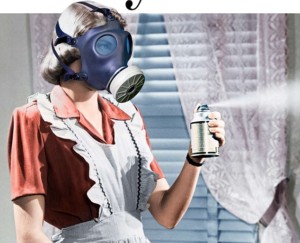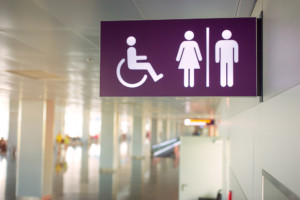A carpet cleaning company was recently engaged to clean the carpets and upholstery of a small office. Next morning the stains were gone, the colours were vibrant again and everyone was happy. Everyone that is, except one employee. What was wrong?
When this person first entered the room, they were smacked with a wall of solvents and fragrance so strong, that their throat swelled up, their eyes itched and their head throbbed. Struggling to think through an intense ‘brain fog’, their productivity levels plummeted and they felt unwell for the next few days.
Unfortunately this experience is repeated across the country, in every type of facility. And because the experience is not necessarily shared, the victims (often women and children) are usually too embarrassed to speak up about it – or may not have have realised the cause.

An asthma attack can be triggered by VOCs
The true cost of fragranced products
Recent research by Professor Steinemann, Melbourne University[1], found that 33 percent of 1098 people randomly surveyed, reported health problems when exposed to fragranced products.
Reactions to fragrances can include migraine headaches, dizziness, feeling tired or weak, breathlessness and nausea. 43 percent of people with asthma registering on the Asthma Foundation NSW website over a six-month period, listed ‘strong smells’ as one of their asthma triggers.
The cost to business, and well as the human cost, is quite staggering. Apart from absenteeism, being subjected to strong fragrances can cause confusion and difficulty with concentration.
Air fresheners and scented cleaning products are known to contribute significantly to indoor pollution. It is also well established that poor indoor air quality (IAQ) results in decreased productivity and may reduce work performance by up to 9 percent.[2]
Way back in 1998, a CSIRO report put the annual cost of poor IAQ to Australian business at $12 billion. So even if workers are not grabbing for the tissue box or Panadol, their ability to think clearly and stay on task could be diminished by constant exposure to scented products.

Not so clean and healthy
Fragrances used in cleaning products and air-fresheners are also linked to some pretty serious health hazards:
1) Volatile organic compounds (VOCs):
VOCs are organic chemicals that can evaporate into the air under normal indoor conditions – allowing them to be easily inhaled and potentially causing a range of respiratory and neurological health problems. In 2011, Steinemann carried out tests on 25 scented cleaning products and found a total of 133 different VOCs in them. Of these, 24 were classified as toxic or hazardous (USA) and only 2 were listed on the MSDS.[3]
2) Cancer:
Most people are surprised to learn that many synthetic fragrances contain IARC listed carcinogens (including those used in perfume and aftershave). Steinemann’s research showed that 44% of the products tested generated at least 1 of 4 carcinogenic hazardous air pollutants (acetaldehyde, 1,4-dioxane, formaldehyde, and methylene chloride).
While a cleaning products may only contain a small amount of fragrance, we are being exposed to a cocktail of scents on a daily basis, from air-fresheners, cleaning agents, disinfectants, laundry detergents, hand-soap, deodorant, perfumes and aftershave etc….
We have no idea what we are breathing in because fragrances do not need to be declared on the label or SDS, nor what the long-term health effects may be. We do know that babies subjected to constant use of scented cleaning agents and air-fresheners have higher rates of asthma.[4]
3) Chemical sensitivity:
For people with chemical sensitivities, negotiating public spaces, such as shopping centres, schools, airports, restaurants and restrooms, is like a minefield. Because of the wide-spread use of automated air-freshener mists, plug-in vaporisers and scented hand-soaps, it can be virtually impossible to avoid them. Chemical-sensitivity in a scented world can be totally debilitating.
For those of us with mild chemical sensitivity, it can just be frustrating and embarrassing trying to pull our brain out of the abyss when working where a scented cleaning agent (or even strong aftershave and laundry detergent) has been used.
And I know this – because I am that ‘employee’ in the introduction.

Cleaning industry dilemma
The hidden cost of scented cleaning products poses a real dilemma for the cleaning industry. Most people understand the hazards associated with solvents, stain removers, strippers and bleach.
But fragrance is usually viewed as a safe and added benefit. In fact, the use of fragranced cleaners and air-fresheners is often demanded by the building users. There is a persistent belief that if they can’t smell a cleaning agent, it hasn’t been cleaned. A bathroom without an air-freshener is considered ‘unhygienic’.
Yet there is a growing international movement for scent-free environments especially in Canada and the USA. Providing scent-free areas if requested by workers with Fragrance Sensitivity, is now a requirement under the ‘Americans with Disabilities Act’ (ADA)[5].
While there is no such legislation in Australia or New Zealand, a growing awareness about indoor air pollutants, and the adoption of building ratings systems with IAQ criteria such as Green-Star Performance and WELL, means this is a smelly issue that the cleaning industry can no longer ignore.

Turn this risk into an opportunity
Turn this risk into an opportunity for creating a real point of difference and show you care about the health and wellbeing of the people in the buildings being cleaned.
High Performance Cleaning means taking a risk prevention approach to achieve high standards through good cleaning practices – rather that relying on stain removers, deodorants and polish that contain solvents to do the work for them, and fragrances to disguise poor cleaning and ventilation.
To sell your fragrance-free approach to the facility manager (who has to deal with complaints from fragrance haters and lovers!) the following ideas can help:
- Offer an optional 100% scent-free choice for your routine cleaning services, with:
- Altered water technology such as Electrolysed and Aqueous ozone water systems
- Microfibre technology with tap water
- Purchase Fragrance-free cleaning agents or products certified by Eco-labels that restrict the use of VOCs and harmful fragrances*
- Train cleaners in good handing techniques to ensure step 1 still delivers the required outcome.
- Provide occupant education to help address the persistent belief that fragrance = clean.
- Develop risk-based Cleaning Plans that explain how each method is designed to protect Indoor Air Quality without compromising performance.
- Find out more HPC Solution’s Innovation or Compliance Package to learn how to develop your own High Performance Cleaning Program offering an effective, fragrance-free cleaning service.
Because in the end, ‘clean’ doesn’t actually have smell
*Note that GECA and Global Green Tag Standards only prohibit certain fragrances and restrict VOCs to 3%.
About the author:

Bridget Gardner is Director and Principal Consultant of HPC Solutions (formerly Fresh Green Clean).
This article was first published in Inclean Magazine, January 2018.
References
[1] Health and societal effects from exposure to fragranced consumer products, 2017, Steinemann A.
[2] The effects of indoor air quality on performance and productivity, Wyon DP
[3] Fragranced consumer products: chemicals emitted, ingredients unlisted, 2010, Steinemann AC, et al.
[4] Asthma link to household cleaning products, 2004, www.medicalnewstoday.com/releases/12545.php
[5] www.laborlawcenter.com/education-center/new-ada-guidelines-for-fragrance-sensitivity

